
Lotus, a latinization of Greek lōtos, is a genus of flowering plants that includes most bird's-foot trefoils and deervetches. Depending on the taxonomic authority, roughly between 70 and 150 species are accepted, all legumes; American species formerly placed in the genus have been transferred to other genera. Lotus species are found in the Eastern Hemisphere and adapted to a wide range of habitats.

The tribe Loteae is a subdivision of the plant family Fabaceae, in the Robinioids. These genera are recognized by the USDA:

Trithuria is a genus of small ephemeral aquatic herb that represent the only members of the family Hydatellaceae found in India, Australia, and New Zealand. All 13 described species of Trithuria are found in Australia, with the exception of T. inconspicua and T. konkanensis, from New Zealand and India respectively. Until DNA sequence data and a reinterpretation of morphology proved otherwise, these plants were believed to be monocots related to the grasses (Poaceae). They are unique in being the only plants besides two members of Triuridaceae in which the stamens are centred and surrounded by the pistils; in Hydatellaceae the resulting 'flowers' may instead represent condensed inflorescences or non-flowers.

Tripodion tetraphyllum is a species of flowering plant in the legume family, Fabaceae. It is an annual herb, commonly known as annual kidney vetch, native to the Mediterranean Basin of southern Europe, North Africa, and western Asia. It grows in the Mediterranean–Sahara transition zone of North Africa, and in anthropic landscapes. It is the sole species in genus Tripodion, which belongs to subfamily Faboideae.
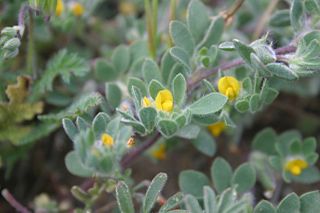
Acmispon brachycarpus is a species of legume known by the common name foothill deervetch. It is native to western North America from Idaho to Texas to northern Mexico, where it is known from many types of habitat. It is an annual herb spreading upright or taking a clumpy or matted form. It is lined with leaves each usually made up of four hairy, somewhat fleshy leaflets each up to about 1 cm long. Solitary yellow, pea-like flowers appear in the leaf axils. The fruit is a legume pod variable in size and shape.

Acmispon parviflorus, synonym Lotus micranthus, is a species of legume. It is known by the common name desert deervetch. It is native to western North America from British Columbia to southern California, where it is known from many types of habitat. It is a hairy to hairless annual herb lined with leaves each made up of small oval leaflets. Solitary flowers appear in the leaf axils. Each is an ephemeral pinkish pealike bloom under a centimeter long. The fruit is a narrow, hairless, wavy-edged legume pod up to about 2.5 centimeters long.

Acmispon rubriflorus, synonym Lotus rubriflorus, is a species of legume endemic to California. It is known by the common name red-flowered bird's-foot trefoil. It is known from only four occurrences with a disjunct distribution.

Acmispon is a genus of flowering plant in the family Fabaceae (legumes), native to North America and the west coast of Chile in South America. It includes several species of American bird's-foot trefoils and deervetches formerly contained in the globally distributed genus Lotus. The former genus Syrmatium is included in Acmispon. The Jepson eFlora accepts only Acmispon.
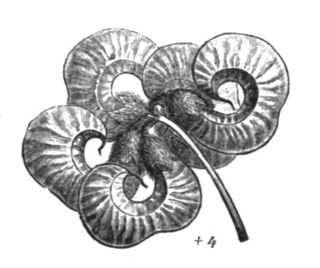
Dorycnopsis is a genus of flowering plants in the legume family Fabaceae. It belongs to the subfamily Faboideae. It includes two species of subshrubs, one native to southwestern Europe and Morocco, and the other native to the Horn of Africa and Yemen.
Hosackia yollabolliensis is a species of flowering plant in the family Fabaceae, native to California. It was first described, as Lotus yollabolliensis, by Philip A. Munz in 1955. It was transferred to Hosackia by D.D. Sokoloff in 2000. It is also known as the Yolla Bolly Mountains bird's-foot trefoil.
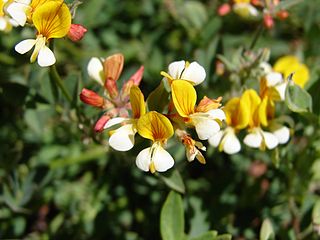
Hosackia is a genus of flowering plants in the family Fabaceae (legumes). It is native to western North America, from British Columbia in Canada to Mexico.

Syrmatium was a formerly accepted genus of flowering plants in the family Fabaceae (legumes), native to the southwestern United States. As of February 2021, it was considered a synonym of Acmispon by Plants of the World Online, and only Acmispon was recognized by the Jepson eFlora.
Terry Desmond Macfarlane is a botanist and taxonomist, who has worked in both Australia and Peru. A senior research scientist at the Western Australian Herbarium, Macfarlane is associate editor of its journal Nuytsia and currently collaborates with researchers across Australia and in Canada, Germany, New Zealand, Russia, Spain and United Kingdom. He was also involved in the development of FloraBase, the Western Australian flora database.
Lotus anfractuosus is a plant in the genus Lotus ranging from Vanuatu to New Caledonia.
Lotus axilliflorus is a perennial plant in the genus Lotus, native to Turkey.

Trithuria austinensis is a species of aquatic plant in the family Hydatellaceae endemic to Western Australia.
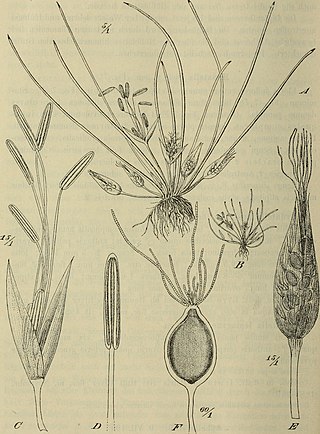
Trithuria australis is a species of aquatic plant in the family Hydatellaceae endemic to Western Australia.
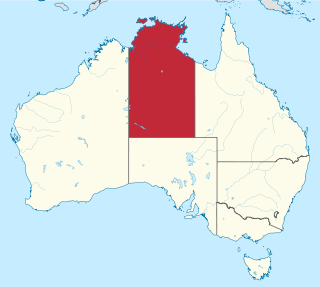
Trithuria cookeana is a species of aquatic plant in the family Hydatellaceae endemic to the Northern Territory, Australia.

Trithuria cowieana is a species of aquatic plant in the family Hydatellaceae endemic to the Northern Territory, Australia.

Trithuria fitzgeraldii is a species of aquatic plant in the family Hydatellaceae endemic to Western Australia.














